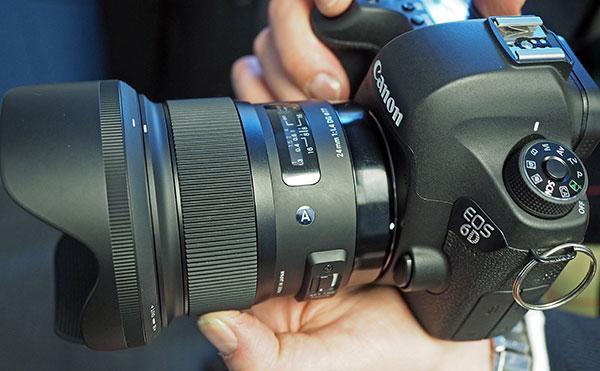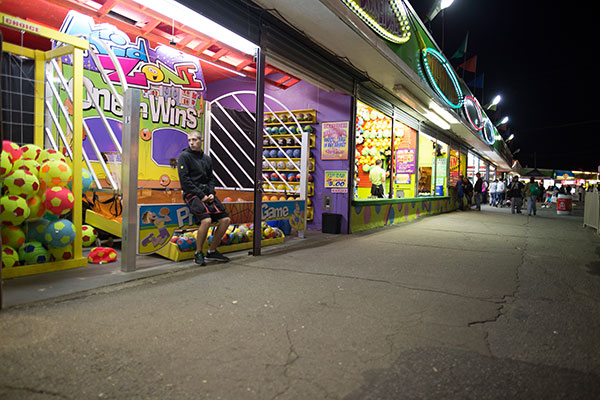Sigma 24mm F/1.4 DG HSM Art Lens Review

Sigma has long been a leader in the third-party lens market, producing an astounding array of glass that’s compatible with major DSLR systems from Nikon and Canon (plus their own camera line) as well mirrorless and other camera manufacturers. While the collection of lenses has been staggering, it’s not always been easy to figure out if a Sigma lens is a high-end professional product or a consumer-level piece of optics from name and price alone.
To combat this brand confusion, Sigma realigned many of its lenses under a category system, with the Art lens representing the pinnacle of the company’s design, or as Sigma explains it “…for those who see photography as a critical expression of self, our Art line offers sophisticated optical performance and abundant expressive power to deliver faithfully on your artistic vision.”
There are nine lenses in the Art series—although three of those lenses are only available for the Micro Four Thirds and Sony’s mirrorless systems. The Sigma 24mm F/1.4 DG HSM is one of the latest Art lenses to go on sale and it joins a very well reviewed and well regarded family of optics with the Sigma 50mm F/1.4 DG HSM Art lens a favorite among photographers looking for excellent quality optics at a reasonable price. (Just last week, Sigma unveiled the Sigma 24-35mm F2 DG HSM Art lens, which the company is calling “the world’s first” full-frame zoom lens with a constant aperture of F/2 throughout the zoom range.)
The 24mm F/1.4 Art lens aims to provide the same mix of high-end optics and affordability in a versatile lens that offers a wider field-of-view. A 24mm lens is ideal for the landscape, travel, street, wedding and event photographer but also a unique portrait lens if used right.
With a retail price of around $850, the Sigma 24mm sits right between the price range of 24mm lenses made by competitors ranging from Canon and Nikon (around $1600) to Samyang (around $500). In fact all of Sigma’s Art lenses advertise a level of performance on par with the best performing lenses from the camera manufacturers, at a price that’s around half of the manufacture’s own comparable lenses.

Build & Features
The 24mm F/1.4 DG HSM Art lens has a solid build—stocky and chunky—just as a professional lens should feel. At just about 3.6 inches long and 23.5 ounces in weight, it’s almost exactly the same size as the Canon 85mm F/1.2L II lens and a touch lighter and shorter than the Samyang 24mm F/1.4 ED AS UMC. On the other hand, the Sigma feels considerably better built than the Samyang.
The 24mm F/1.4 DG HSM is, according to Sigma “aimed at being the new standard for fast aperture wide angle prime lenses.” Sigma says that their design specifically optimizes edge-to-edge performance and that the aspherical lens elements create “great performance wide open.” Traditionally, inexpensive wide primes suffer from vignetting at the edges, especially when shot wide open, but Sigma claims to have created a lens with excellent edge sharpness and low levels of vignetting.
There are 15 lens elements in 11 groups and nine diaphragm blades are used to create soft, creamy “bokeh,” the term used to describe the soft out-of-focus background area in a photo when shot wide open.
Since Sigma spent so much time working on edge sharpness at wide apertures and designed the 24mm F/1.4 DG HSM to create soft focus blur when shot close to the maximum f/1.4, I naturally spent a lot of time shooting this lens wide but I also stopped down as often as possible to get a sense for the depth and detail possible with Sigma’s new Art lens.
Performance
Right off the bat, I noticed that the Sigma 24mm F/1.4 DG HSM is an incredible performer. I paired the lens with a full frame Canon EOS 6D and found that it was pretty difficult to miss a shot, thanks to the combination of the lens’s speedy autofocus. Many low-end Sigma lenses I’ve tested focus more slowly than their comparable lenses from a manufacturer, but not so with the 24mm Art lens.
The focusing speed even held up in later tests at a New Jersey Shore amusement park as light dropped way below optimal following sunset while subjects spun around on carnival rides. There aren’t a lot of high-end portrait lenses that can keep up with such erratically moving subjects, but the Sigma 24mm F/1.4 DG HSM is one of them.
On the other hand, I noticed that the image quality of my first shots was close, but not exactly as good as the 50mm Art lens could produce. This is hard to back up with numerical data, especially since the Sigma 50mm Art I tested was on the Nikon platform and the 24mm was on Canon, but the two lenses don’t feel exactly on par.
Looking at Sigma’s site though, I don’t think they’re intended to be.
Here are the bullet points for the Sigma 24mm lens:
• Large aperture wide-angle lens
• Performance similar to 35mm F1.4 Art & 50mm F1.4 Art
• FLD and SLD glass elements to reduce distortion and chromatic aberration
Here though are the bullet points for the 50mm lens:
• Completely redesigned and reengineered
• Exceptional Image Quality
• Incredible focal point sharpness when wide open
• Pairs well with Pro-Level DSLR’s
• MTF A1-tested
Clearly, there’s a bit more going on with the 50mm lens than the 24mm. It’s important to keep in mind that the 50mm F/1.4 DG HSM is one of the crispest, cleanest lenses I’ve ever tested. It’s hard for a 24mm lens to deliver the same performance of a 50mm at the same size and price, so this isn’t surprising, but it’s something to keep in mind.
That said, the 24mm proved itself even on my first outing, a quick trip to pick up someone at our local train station. The soft focus turned a low-contrast and overcast day into a sharp portrait session, with the wide-open aperture shots turning an otherwise dull train station into a soft-focus background.


In the Field
There is probably no more demanding place to test a lens than a beach in the noonday sun, so that’s where I took the Sigma 24mm F/1.4. The bright, undiffused overhead sun, reflective sand and the high contrast is torture for a lens. If vignetting or lens aberrations are going to appear, they’re going to appear here.
While there certainly is some minor vignetting at the corners, it’s incredibly slight, much less than I’ve seen on other lenses and much less than I had expected. In fact the vignetting at the edges was so slight I had to consciously look for it, while with other 24mm lenses I’d start my post-processing immediately correcting for it.

Even in very harsh conditions—direct overhead sunlight and the camera held low to the reflective sand, the images were crisp and bright and full of detail without hints of aberration or image artifacts. Obviously the images are very high contrast, as is natural for the conditions of the lighting, but the high contrast doesn’t make for unpleasant images. That’s thanks to both the quality of the lens and the high dynamic range of the Canon 6D’s sensor.
It wasn’t until I was shooting later in the day, photographing with the camera nearly vertical at a sky with a rapidly setting sun that I started to see vignetting at the corners of the images. The image quality of the lens at the corners appeared to me as bright and clear as a high-end 50mm or 85mm lens, not a 24mm.

Night Shooting on the Boardwalk
As day turned to night I took the lens a nearby amusement park to see how well the Sigma 24mm F/1.4 DG HSM Art did in low light. I’m fascinated by the lights and colors of carnivals. The incredible dynamic range of a carnival with it’s bright lights contrasted against the darkness of the night sky is a wonderful opportunity for great photos, but is also a stress test for lenses and cameras alike.

Again, the Sigma 24mm F/1.4 DG HSM Art lesn really held up. I specifically shot directly into lights, metered for shadows but shot with highlights in the scene, dragged the shutter, and challenged the lens with every condition I could find. I couldn’t find a situation in which the lens let me down.
And thanks to the 24mm focal length I could go easily from a wider-angle landscape lens to a portrait lens simply by changing my distance to the subject.


As the sun set on the horizon I headed down to the to the beach and shot toward the sunset, silhouetting subjects in the foreground. As a family played in the falling light of the sunset, I captured them running across the beach.
At f/13 at full size, this shot has some incredible detail. The posts of the pier are clearly seen on the left of the frame, you can even see the waves behind the piers.

The only image quality issue is the haloing around the sun, which is completely to be expected from a light source as bright as the sun, especially in an image with such wide dynamic range. Again, much of this incredible image quality is thanks to the sensor on the Canon 6D, but the Sigma 24mm Art lens allows the Canon body to really shine.
After the sun set I continued to shoot at the amusement park and even as the ISO crept up the image quality from the Sigma lens continued to produce incredible images, even under the artificial lighting of the carnival rides.

On the Street
One of the things I like best about the Sigma 24mm F/1.4 HG DSM A lens has nothing to do with the image quality, but has to do with the focal length. The 24mm length is one of my favorites because of its versatility—it can go from landscape work to portrait work with a simple change in distance to subject.
While 24mm does create some distortion on a super-close portrait, this is easily corrected with today’s post-processing tools like Adobe Lightroom, and it’s not a bad look if it’s used purposefully.
But the 24mm focal length is incredibly versatile because it can be used for just about anything besides telephoto use. I was able to go from street photography to landscape work to portrait work all with the same lens.
In fact, my favorite use of the 24mm was to shoot “street” shots by holding the Canon 6D at my waist and capture people at the amusement park as they went about their day. Carnivals are great places to people watch, but raising a camera to your eye and pointing it at a subject is a great way to get someone to panic.
Shoot with the 24mm at the hip and you can get some great shots first and then approach the person if you’d like and shoot a portrait.

Conclusion
Sigma’s series of Art lenses is a great compliment to the company’s existing array of high-end, high-quality optics. The 24mm F/1.4 HG DSM Art is only slightly less capable than the 50mm model in the series and the $850 price tag makes it affordable for even the budget-minded photographer.
For a photographer looking for an incredibly capable wide-angle lens that is free from imaging defects or artifacts, the Sigma 24mm F/1.4 HG DSM Art is an incredible choice and would be a welcome addition to any photographer’s camera bag.
- Log in or register to post comments

















































